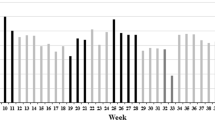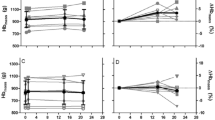Abstract
Recently, endurance athletes have used several novel approaches and modalities for altitude training including: (i) normobaric hypoxia via nitrogen dilution (hypoxic apartment); (ii) supplemental oxygen; (iii) hypoxic sleeping devices; and (iv) intermittent hypoxic exposure (IHE).
A normobaric hypoxic apartment simulates an altitude environment equivalent to approximately 2000 to 3000m (6560 to 9840ft). Athletes who use a hypoxic apartment typically ‘live and sleep high’ in the hypoxic apartment for 8 to 18 hours a day, but complete their training at sea level, or approximate sea level conditions. Several studies suggest that using a hypoxic apartment in this manner produces beneficial changes in serum erythropoietin (EPO) levels, reticulocyte count and red blood cell (RBC) mass, which in turn may lead to improvements in postaltitude endurance performance. However, other studies failed to demonstrate significant changes in haematological indices as a result of using a hypoxic apartment. These discrepancies may be caused by differences in methodology, the hypoxic stimulus that athletes were exposed to and/or the training status of the athletes.
Supplemental oxygen is used to simulate either normoxic (sea level) or hyperoxic conditions during high-intensity workouts at altitude. This method is a modification of the ‘high-low’ strategy, since athletes live in a natural terrestrial altitude environment but train at ‘sea level’ with the aid of supplemental oxygen. Limited data regarding the efficacy of hyperoxic training suggests that highintensity workouts at moderate altitude (1860m/6100ft) and endurance performance at sea level may be enhanced when supplemental oxygen training is utilised at altitude over a duration of several weeks.
Hypoxic sleeping devices include the Colorado Altitude Training (CAT) Hatch™ (hypobaric chamber) and Hypoxico Tent System™ (normobaric hypoxic system), both of which are designed to allow athletes to sleep high and train low. These devices simulate altitudes up to approximately 4575m/15006ft and 4270m/14005ft, respectively. Currently, no studies have been published on the efficacy of these devices on RBC production, maximal oxygen uptake and/or performance in elite athletes.
IHE is based on the assumption that brief exposures to hypoxia (1.5 to 2.0 hours) are sufficient to stimulate the release of EPO, and ultimately bring about an increase in RBC concentration. Athletes typically use IHE while at rest, or in conjunction with a training session. Data regarding the effect of IHE on haematological indices and athletic performance are minimal and inconclusive.


Similar content being viewed by others
References
Levine BD, Stray-Gundersen J. A practical approach to altitude training: where to live and train for optimal performance enhancement. Int J Sports Med 1992; 13 Suppl. 1: S209-S212
Stray-Gundersen J, Levine BD. ‘Living high and training low’ can improve sea level performance in endurance athletes. Br J Sports Med 1999; 33: 150–4
Rusko, HK. New aspects of altitude training. Am J Sports Med 1996; 24 Suppl. 6: S48-S52
Levine BD, Stray-Gundersen J, Duhaime G, et al. Living high - training low: the effect of altitude acclimatization/normoxic training in trained runners [abstract]. Med Sci Sports Exerc 1991; 23 Suppl. 4: S25
Levine BD, Stray-Gundersen J. ‘Living high — training low’: effect of moderate-altitude acclimatization with low-altitude training on performance. J Appl Physiol 1997; 83: 102–12
Laitinen H, Alopaeus K, Heikkinen R, et al. Acclimatization to living in normobaric hypoxia and training at sea level in runners [abstract]. Med Sci Sports Exerc 1995; 27 Suppl. 5: S109
Rusko HK, Leppavuori A, Makela P, et al. Living high, training low: a new approach to altitude training at sea level in athletes [abstract]. Med Sci Sports Exerc 1995; 27 Suppl. 5: S6
Rusko HK, Tikkanen H, Paavolainen L, et al, . Effect of living in hypoxia and training in normoxia on sea level V̇O2max and red cell mass [abstract]. Med Sci Sports Exerc 1999; 31 Suppl. 5: S86
Mattila V, Rusko H. Effect of living high and training low on sea level performance in cyclists [abstract]. Med Sci Sports Exerc 1996; 28 Suppl. 5: S157
Nummela A, Rusko H. Acclimatization to altitude and normoxic training improve 400-m running performance at sea level. J Sports Sci 2000; 18: 411–9
Piehl-Aulin K, Svedenhag J, Wide L, et al. Short-term intermittent normobaric hypoxia — haematological, physiological and mental effects. Scan J Med Sci Sports 1998; 8: 132–7
Ashenden MJ, Gore CJ, Martin DT, et al. Effects of a 12-day ‘live high, train low’ camp on reticulocyte production and haemoglobin mass in elite female road cyclists. Eur J Appl Physiol 1999; 80: 472–8
Ashenden MJ, Gore CJ, Dobson GP, et al. Simulated moderate altitude elevates serum erythropoietin but does not increase reticulocyte production in well-trained runners. Eur J Appl Physiol 2000; 81: 428–35
Ashenden MJ, Gore CJ, Dobson GP, et al. ‘Live high, train low’ does not change the total haemoglobin mass of male endurance athletes sleeping at a simulated altitude of 3000 m for 23 nights. Eur J Appl Physiol 1999; 80: 479–84
Gore CJ, Gawthorn KM, Clark S, et al. Does intermittent normobaric hypoxic exposure uncouple submaximal V̇O2 and power? [abstract]. Med Sci Sports Exerc 1999; 31 Suppl. 5: S190
Roberts AD, Martin DT, Gore CJ, et al. Live high: train low altitude exposure enhances anaerobic energy capacity [abstract]. Med Sci Sports Exerc 2000; 32 Suppl. 5: S47
Nummela A, Alberts M, Rijntjes RP, et al. Reliability and validity of the maximal anaerobic running test. Int J Sports Med 1996; 17 Suppl. 2: S97-S102
Nummela A, Mero M, Stray-Gundersen J, et al. Important determinants of anaerobic running performance in male athletes and non-athletes. Int J Sports Med 1996; 17 Suppl. 2: S91-S96
Powers SK, Lawler J, Dempsey JA, et al. Effects of incomplete pulmonary gas exchange on V̇O2max. J Appl Physiol 1989; 66: 2491–5
Peltonen JE, Rantamaki J, Niittymaki SPT, et al. Effect of oxygen fraction in inspired air on rowing performance. Med Sci Sports Exerc 1995; 27: 573–9
Peltonen JE, Leppavuori AP, Kyro K-P, et al. Arterial haemoglobin oxygen saturation is affected by FIO2 at submaximal running velocities in elite athletes. Scand J Med Sci Sports 1999; 9: 265–71
Nummela AT, Hamalainen IT, Rusko HK. Effect of hyperoxia on SaO2, blood pH and heart rate recovery during intermittent exercise [abstract]. Med Sci Sports Exerc 2000; 32 Suppl. 5: S358
Hamalainen IT, Nummela AT, Rusko HK. Training in hyperoxia improves 3000-m running performance in national level athletes [abstract]. Med Sci Sports Exerc 2000; 32 Suppl. 5: S47
Graham TE, Petersen PK, Saltin B. Muscle and blood ammonia and lactate responses to prolonged exercise with hyperoxia. J Appl Physiol 1987; 63: 1457–62
Howley ET, Cox RH, Welch HG, et al. Effect of hyperoxia on metabolic and catecholamine responses to prolonged exercise. J Appl Physiol 1983; 54: 59–63
Linossier M-T, Dormois D, Arsac L, et al. Effect of hyperoxia on aerobic and anaerobic performances and muscle metabolism during maximal cycling exercise. Acta Physiol Scand 2000; 168: 403–11
Hughson RL, Kowalchuk JM. Kinetics of oxygen uptake for submaximal exercise in hyperoxia, normoxia, and hypoxia. Can J Appl Physiol 1995; 20: 198–210
Welch HG. Effects of hypoxia and hyperoxia on human performance. Exerc Sport Sci Rev 1987; 15: 191–221
Chick TW, Stark DM, Murata GH. Hyperoxic training increases work capacity after maximal training at moderate altitude. Chest 1993; 104: 1759–62
Morris DM, Kearney JT, Burke ER. The effects of breathing supplemental oxygen during altitude training on cycling performance. J Sci Med Sport 2000; 3: 165–75
Gamow RI, Geer GD, Kasic JF, et al. Methods of gas-balance control to be used with a portable hyperbaric chamber in the treatment of high altitude illness. Wilderness Med 1990; 1: 165–80
Bartsch P. Treatment of high altitude diseases without drugs. Int J Sports Med 1992; 13 Suppl. 1: S71-S74
Eckardt KU, Boutellier U, Kurtz A, et al. Rate of erythropoietin formation in humans in response to acute hypobaric hypoxia. J Appl Physiol 1989; 66: 1785–8
Knaupp W, Khilnani S, Sherwood J, et al. Erythropoietin response to acute normobaric hypoxia in humans. J Appl Physiol 1992; 73: 837–40
Hellemans J. Intermittent hypoxic training: a pilot study. Proceedings of the Second Annual International Altitude Training Symposium; 1999 Feb 18–20; Flagstaff (AZ), 145–54
Rodriguez FA, Ventura JL, Casas M, et al. Erythropoietin acute reaction and hematological adaptations to short, intermittent hypobaric hypoxia. Eur J Appl Physiol 2000; 82: 170–7
Frey WO, Zenhausern R, Colombani PC, et al. Influence of intermittent exposure to normobaric hypoxia on hematological indexes and exercise performance [abstract]. Med Sci Sports Exerc 2000; 32 Suppl. 5: S65
Terrados N, Melichna J, Sylven C, et al. Effects of training at simulated altitude on performance and muscle metabolic capacity in competitive road cyclists. Eur J Appl Physiol 1988; 57: 203–9
Meeuwsen T, Hendriksen IJM, Holewijn M, et al. Training-induced increases in sea-level performance is enhanced by acute intermittent hypobaric hypoxia: a 2 year crossover study [abstract]. Med Sci Sports Exerc 2000; 32 Suppl. 5: S251
Vallier JM, Chateau P, Guezennec CY. Effects of physical training in a hypobaric chamber on the physical performance of competitive triathletes. Eur J Appl Physiol 1996; 73: 471–8
Rodriguez FA, Casas H, Casas M, et al. Intermittent hypobaric hypoxia stimulates erythropoiesis and improves aerobic capacity. Med Sci Sports Exerc 1999; 31: 264–8
Melissa LM, MacDougall JD, Tarnopolisky MA, et al. Skeletal muscle adaptations to training under normobaric hypoxic versus normobaric conditions. Med Sci Sports Exerc 1997; 29; 238–43
Green H, MacDougall J, Tarnopolisky M, et al. Down regulation of Na+-K+-ATPase pumps in sketetal muscle with training in normobaric hypoxia. J Appl Physiol 1999; 86: 1745–8
de Merode A. International Olympic Committee Medical Commission prohibited classes of substances and methods of doping [letter]. Comite Internationale Olympique; 2000 Feb 15; Lausanne. In: Bowers LD, editor. United States Anti-Doping Agency guide to prohibited classes of substances and prohibited methods of doping. Colorado Springs (CO): United States Anti-Doping Agency, 2000: 3
Norwegian Ministry of Sport Steering Committee. Press release. 1998 May
Author information
Authors and Affiliations
Corresponding author
Rights and permissions
About this article
Cite this article
Wilber, R.L. Current Trends in Altitude Training. Sports Med 31, 249–265 (2001). https://doi.org/10.2165/00007256-200131040-00002
Published:
Issue Date:
DOI: https://doi.org/10.2165/00007256-200131040-00002




